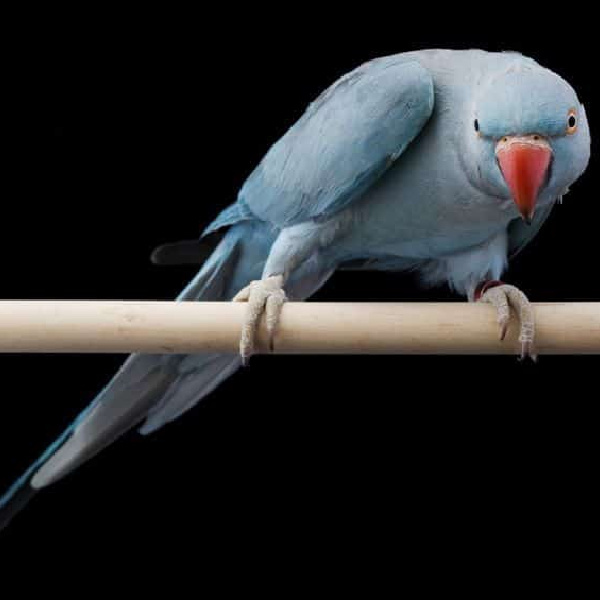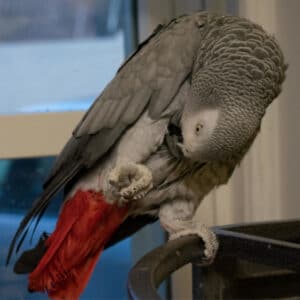Last Updated on by Mitch Rezman
We rescued a 15-year-old African ringneck about two months ago and renamed him Keto.
If he gets near my hand or arm he will lash out and try to bite me.
I’m very careful to avoid this.
Interestingly enough Catherine will draw him out of the cage with his big bell toy and he will play in her lap for half an hour, as long as she has the bell toy.
He will do anything for the bell toy.
BTW this an interesting question from Quora.
Keto has no interest in biting her which is one clue that he was probably mishandled by a man in his lifetime.
The cage we have him in does not allow for changing food and water dishes from the outside so we have to put our hands in the cage.
One of the things Catherine pointed out to me was “I don’t talk to him enough while I’m working within the bird cage”.
Do not take that toy video
[videopress nHKtIOFQ]
I try my very best not to get bitten.
Today I was changing the food dish, and jingling his bell toy.
As I was setting the food dish in place he moved as fast as any superhero and was able to get a piece of my finger.
Yet he definitely likes me and will fly to me but if I don’t have enough clothing on once he lands on me he will light my arm.
Today he landed on my arm.
He will begin clicker training shortly.
Clicker training is simply not effective with a bird inside of the cage by the way.
I don’t know what a training diet is but it sounds inhumane and there is nothing positive about it.
We rescued Keto from a deceased woman’s house through our private bird rescue network.
We know he’s about 15 because we did a forensic analysis through Facebook and found images going back 15 years.
He’s got a big beautiful personality.
His full spectrum lighting comes on at 7:30 in the winter and goes back to 8:30 when daylight saving time ends so it’s very consistent.
My routine since about a month into our relationship has been to uncover his cage when the light comes on and open his bird cage door.
Keto will try to bite me if i get too close and he sees “skin” and yet he shows affection for me.
[videopress PJRCT6fp]
As a counterpoint, he has no interest in biting Catherine so relationships are definitely a factor.
He is then free to go wherever he wants.
He likes to visit our aviary with 10 budgies.
But he also flies back and forth between his cage and the bedroom because I rarely get up at 7:30 AM.
It’s like he’s checking on me.
When I do get up in the morning I like to sit in my recliner have coffee and watch the news.
Keto will fly from his cage the top of recliner and back several times as if he’s checking on me.
If I’m not up by 8:30 or nine he will also fly onto the bed, again is if he’s checking on me.
He’s in love with mirrors and has one in all of his four cages so he can talk to his best friend.
In our bedroom we have an entire wall that is mirrored which Keto discovered so he will sit on a play stand, chatting with his best friend waiting for me to awake.
If anyone tells you that this needs to be done or that needs to be done doesn’t understand birds very well as there are no rules.
I feel that over the next 10 or 12 months I can get around the biting by not only avoiding it but encouraging him to land on my arm but keeping my arm in motion keeping him off balance.
We call that “the earthquake”
Once or twice a day he gets a special treat for me like a peanut or a piece of walnut (he doesn’t like almonds).
We also give them human food seven days a week like it or not.
At the end of the day the most important thing is to avoid getting bitten and simply provide a consistent environment making you a trustworthy caregiver.
Keto comes to work with us as weather permits but he also travels with us to a campground in Indiana almost every weekend where he has his travel trailer cage.
He’s a nervous talker.
When my wife or I walk into the room he will begin a tirade of sounds and words.
This is how we know that he’s excited to see us.
Keto says “Hi baby” video
https://videopress.com/v/lPsax0ti
For some reason he will try to bite my fingers through the bars when I close his cage door but he does not do this with my wife so we think he may have had possible abuse issues with a male human in his past.
He’s a great little bird so were giving him as long as it takes to reduce his aggression.
This question comes from the Google My Business community.
GMB
kenneth shaffer
good evening Mitch, we recently put up an outside aviary for our rescue Indian ring neck. we do not have regular screening up because we were afraid it would keep out the UV Light. should we use that because of bugs, bees and mosquitos? We need help
Greetings Kenneth
We love ringnecks
I recently rescued one you can read about that here.
https://windycityparrot.com/blog/2018/08/22/great-green-indian-ringneck-rescue-caper/
I don’t know your location I’m going to assume it’s in Illinois because you reached out on GMB?
I wouldn’t worry about UV light.
There is not a shred of written evidence with the conclusion that light helps birds better synthesize vitamin D.
Great for reptiles and herbivores who have their a single integumentary system, their skin.
Birds have three, skin, nails and feathers.
Light must be absorbed through the skin to synthesize vitamin D3 but a bird feathers covers the skin.
As methodical as birds are, the process of preening, starting at the uropygial (preening) gland then running the goo across its feathers using it’s beak, very little of the oil ever makes it to the birds skin but is another component necessary for vitamin D synthesis
My good friend Josee Birmingham who manages https://hari.ca/ has done extensive testing with her 250 pairs of parrots.
Working in conjunction with the university of guelph’s veterinary College, she’s the only person that I know it is actually been testing for light therapy on parrots.
The facility employs 3 avian veterinarians and a number of veterinary techs on staff.
Her boss Mark Hagen, one of the three brothers that runs Hagen internationally has a Masters degree in agriculture that he is uses to engineer Hagen (HARI) bird food line
They run blood tests after scheduled exposure to full-spectrum lighting with UVA and UVB and have seen no increase whatsoever in vitamin D3 levels.
One of my many posts on birds and lighting
The good news is where convinced that light can be used to control hormonal behavior.
Simply having full-spectrum lighting no more than 6 inches over a cage set to a 12 hour on-off cycle will help synchronize a birds circadian rhythms keeping the more hormonally balanced.
We also found that exposing chronic egg laying birds (a possible death sentence) to between 72 and 168 hours of light while in a cage can shut down a bird’s reproductive system by “resetting it’s circadian clock” with no pharmaceutical intervention.
The crux of your issue is that bugs and bees are not a problem, mosquitoes are.
If mosquitoes are out, your bird should not be.
Greater danger comes from prey animals likes feral cats, rats, mice, raccoons and predatory birds.
Outdoor aviaries should not be allowed to sit on dirt or grass as animals can burrow into the ground gaining access to the cage.
An aviary must on a concrete slab or pavers.
A sharp nailed claw swipe to a sleeping bird next to a cage wall, is all it takes.
I would not leave your ringneck unsupervised as animals move rapidly when motivated by food which is the last thing you want your ringneck to become.
My intent is not to suck the fun out of the outdoor aviary adventure, simply to point out the pitfalls.
Much can be done to mitigate these issues like placing the aviary in its own outdoor room.
This video may serve as a guide
Best of luck
mitchr
Author Profile
Latest entries
 The Traveling BirdJune 26, 2025Can You Name 5 Parrot Species That Are Living Wild in the USA?
The Traveling BirdJune 26, 2025Can You Name 5 Parrot Species That Are Living Wild in the USA? Bird BehaviorJune 26, 2025How is it Parrots Are Problem Solvers Social Animals and Even Use Tools?
Bird BehaviorJune 26, 2025How is it Parrots Are Problem Solvers Social Animals and Even Use Tools? Bird & Parrot AnatomyJune 25, 2025How a Tiny Chemical Modification Makes Parrots Nature’s Living Paintings
Bird & Parrot AnatomyJune 25, 2025How a Tiny Chemical Modification Makes Parrots Nature’s Living Paintings PigeonsJune 20, 2025How Do Parrots Thrive in Cities Outside Their Native Habitats?
PigeonsJune 20, 2025How Do Parrots Thrive in Cities Outside Their Native Habitats?




